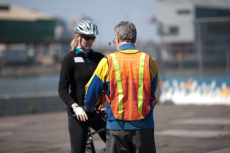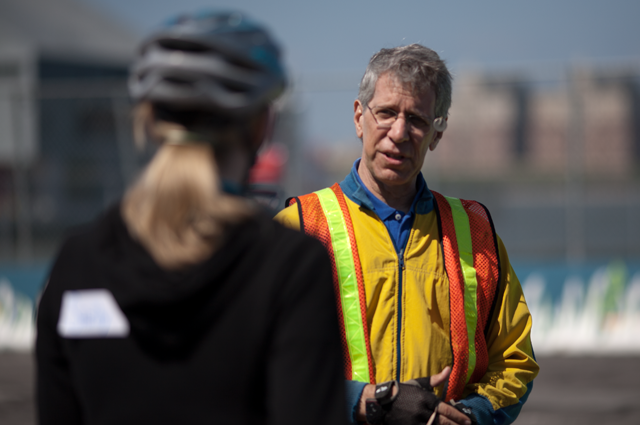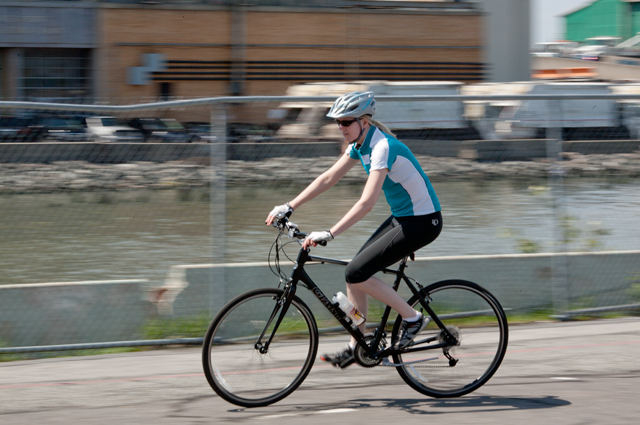Cyclist
Purpose: To know how to ride a bicycle safely so you can take bicycle trips.
 Out for a Spin
Out for a Spin
I take a street skills class and learn the ins and outs of big city cycling.
Last summer, after years of procrastination fueled by fear, I bought a bicycle. Though I’d been wanting to take up cycling for some time, I’d been scared off, terrified as an urban resident to ride the frenetic streets of this mad city. But finally, my desire for fun and exercise outweighed my trepidation, and I purchased the bike.
I joined a bike club but after two outings, my enthusiasm petered out. I wasn’t prepared for riding in the big city. There are so many different scenarios—bike paths intersected by street crossings, bike lanes that mysteriously vanish, shared lanes, right and left turns with or against traffic—you have to maintain constant vigilance and be able to make lightening-quick judgment calls. If I was going to get around my urban environment adeptly on bicycle, I would need some high-level training.
Happily, the nonprofit organization Bike New York offers free bicycle education classes, so I signed up for Street Skills 101, a lecture on traffic rules followed by a half-day ride through the city.
The ride portion of the class began at Manhattan’s Pier 54, an empty, open space, out of harm’s way, perfect for practicing cycling maneuvers, much like the empty parking lot where my father taught me to drive. I was the first to arrive and as I walked my bike onto the pier, I was greeted by the class’s instructor, Lance Jacobs, an energetic, fiftyish man wearing a pair of glasses with a miniature clip-on rear-view mirror.
He launched right into the lesson by asking me to ride up and back the length of the pier so he could assess my ability. Of course he would see that I was no novice, I thought to myself as I rode under his watchful eye. But to my surprise he did in fact detect a problem straightaway. “Your seat looks too high,” he said, and after a quick adjustment with the tools in his portable kit, he set my saddle to the right position, instantly improving my balance and handling proficiency.
 A naturally gifted teacher, Lance possesses that favorable combination of authority and congeniality that engenders trust, and I felt secure as one of his charges for the day. There were four of us in attendance, all women, none with much practice riding in traffic. We were led through a bike safety check, skills drills, and then finally, a foray out onto the real streets of Manhattan.
A naturally gifted teacher, Lance possesses that favorable combination of authority and congeniality that engenders trust, and I felt secure as one of his charges for the day. There were four of us in attendance, all women, none with much practice riding in traffic. We were led through a bike safety check, skills drills, and then finally, a foray out onto the real streets of Manhattan.
Bike New York classes are held on weekends, when traffic is a little calmer than on weekdays and “thermostats are down on drivers’ tempers,” says Lance, who’s been biking the city streets for most of his life. Still, this would be no leisure ride. It was New York City after all, a town of 8 million residents, most of whom appeared to be out that day. Just merging onto the bike path from the pier proved challenging: fellow cyclists, pedestrians, roller skaters, dogs on leash—all moving rapidly and chaotically in both directions. An opening had to be quickly seized.
I never used to be so afraid of riding my bike. When I was young I rode all over my neighborhood without any worry. I’d speed down hills into sharp hairpin turns, enjoying the wind in my face; I’d hold contests with myself to see how long I could go without touching the handlebars. These were pre-helmet days and while I shared the road with cars, I never felt vulnerable.
Although there was less traffic to deal with on the streets of suburban Los Angeles than in New York City, in retrospect, I don’t think it was really that much safer. It’s just that I was young and blissfully ignorant of all that could go wrong. My parents were in charge; they did the worrying for me. Now, as an adult, the onus has fallen to me. I’ve read the bicycle death and accident statistics. I’ve known two people who’ve been hit by cars while riding in the city. I’ve been eye-witness to three incidents of cyclists crashing into car doors flung open into their path.
They say you never forget how to ride a bike, but apparently I’d forgotten how to ride without fear. No longer the carefree California girl, now I was a two-wheeled bundle of nerves heading across the West Side Highway straight into the heart of Manhattan. Even on a relatively relaxed Sunday, the streets of New York are jumping with activity. Like a hyperkinetic version of Frogger, there’s one obstacle after the next; although to Lance’s mind, it was the perfect training ground.
“Oh, good, an obstruction!” he said, spotting a car double-parked ahead of us in the bike lane on the narrow street. Here was our chance to apply our newly acquired skills. We would need to navigate into moving traffic, “taking the lane” in order to discourage cars from trying to dangerously pass us, then get around the double-parker and back into the bike lane. Lance was to go first, then we would each, one by one, follow suit. As it turned out, the car drove away before anyone but Lance did the move. That’s the thing with city traffic, it’s in constant flux. But that’s precisely what we were here to learn to deal with, and it wouldn’t be long before we’d be put to the test again.
 It’s a good time to be a cyclist in New York City. Ever since Mayor Bloomberg appointed bicycle advocate Janette Sadik-Khan as commissioner of the Department of Transportation in 2007, the city has been undergoing a cycling makeover that has resulted in 500 miles of bike lanes stretching through all five boroughs and a ridership that’s more than doubled from 2007 to 2011, and keeps growing each year. But even with all the pro-cycling initiatives in place, cyclists and motorists still have to cope with one another.
It’s a good time to be a cyclist in New York City. Ever since Mayor Bloomberg appointed bicycle advocate Janette Sadik-Khan as commissioner of the Department of Transportation in 2007, the city has been undergoing a cycling makeover that has resulted in 500 miles of bike lanes stretching through all five boroughs and a ridership that’s more than doubled from 2007 to 2011, and keeps growing each year. But even with all the pro-cycling initiatives in place, cyclists and motorists still have to cope with one another.
The painted bike path on Eighth Avenue is separated from street traffic by a row of parked cars and a median, making it possible to ride protected from the flow of cars on the avenue. However, at every intersection, the bike path disappears and cyclists must get into the lane of cars turning left, westbound off of the avenue, then return to the path on the other side of the intersection.
Most cyclists it seems, at least from what I observed, don’t cross the intersection this way. Instead, they travel in a straight line through the intersection, hoping that the drivers will see them and yield to them. It is in fact less dangerous to enter the lane of moving traffic.
Vehicular cycling, riding a bike like it’s a car, is the cornerstone of Lance’s approach. Bike lanes are a “mixed blessing,” he says, explaining that while they work to inform drivers that cyclists have a right to be on the road, they can also create a false sense of protective safety from vehicles. In the city, that’s just not the case, so better to learn how to operate on the streets. That means “behaving as a full participant, taking the lane, riding for maximum visibility, communicating with drivers.” And, above all, riding with confidence.
It also means obeying all traffic laws, including light signals. Even as other cyclists blast through red lights and make you feel “like a subhuman” for waiting for the light to turn green, Lance insists it’s a safer way to ride. It lets drivers know that you’re just another vehicle on the road, same as them, and therefore predictable. “They understand what I’m going to do,” he says. “I’ve formed a camaraderie with them. We’re working within the same system.”
To show us exactly what he meant, Lance gathered us together and had us observe as he demonstrated the correct procedure. We watched as he signaled, made eye contact to be assured the driver understood his intention, and cycled in front of the car and across the street. He told us it would now be our turn and we were to wait for traffic to come then give it a try.
As a stream of heavy traffic began to rush up the avenue, Lance called out for me to go first. I was a little nervous but also pleased that he’d chosen me to lead the exercise. Maybe because he expressed confidence in me, I felt confident myself as I rode up to the intersection, looked over my shoulder as I’d been taught, and saw a cab, at the lead of the pack, approaching. I signaled to him, pedaled quickly in front of him into his lane and rode across the intersection and back into the bike path where Lance was waiting, like a proud father, to congratulate me. “You did it!” he said. And for one moment, I felt like a star player, who’d just scored the team’s winning point.
That merge was the most difficult move of the day, but there were plenty of other challenges as we made our way up to Herald Square and back to the West Side Greenway. No matter how observant, careful, and safe you try to be, New York City streets are just too packed and unpredictable to eliminate risk.
At one point, we turned a corner into a bike lane and were met with a cyclist coming straight toward us—a common occurrence in the city. “Ring your bell at him,” Lance advised, and I gladly obliged, adding in a few more dings than absolutely necessary, eager to express my frustration at the law-breaker. Lance took a different tack, and informed the man that he was going the wrong way in such a disarming nature that the man genuinely apologized.
Here was a seasoned urban cyclist unagitated by the hazardous behavior of others on the road, yet he’d also been able to assert his rights as a law-abiding citizen. It’s not often that I’ve witnessed confrontation without aggression, and it was an eye-opening experience. I wasn’t sure I could pull it off myself, but perhaps I didn’t have to lay into my bell with quite so much gusto. After all, what did I expect on the streets of New York? This wasn’t a leisurely ride along a bucolic backcountry road. Nor was it a return to the carefree days of my youth, taking hills at breakneck speed. But I was beginning to see that city cycling is its own kind of fun, tough but exhilarating. And with the right training, I was finding it wasn’t quite as intimidating anymore.
